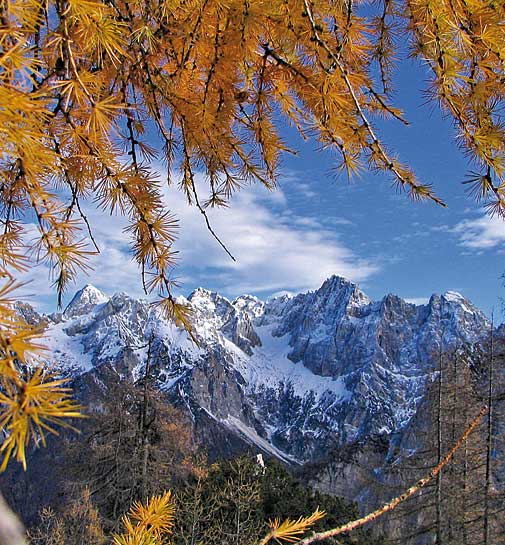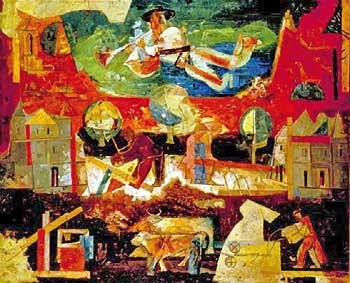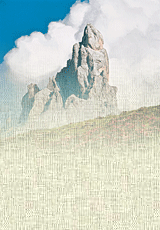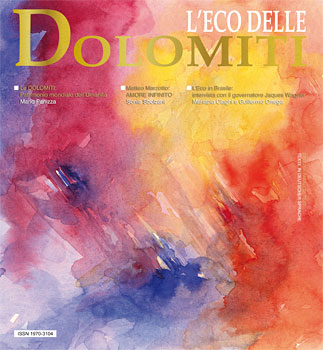From the Alps to the Tatras
Nicolas Boldych

Western Janus
 For me, the horizon of Europe is not the plain or the sea but the mountains that block the way to the sea or the plain; mountains that, subdividing it, give it that European body made of unity and fragmentation. Ones gaze rises and, rather than losing itself in the distance, is fixed on albos, the “world of light” that fascinated the Celts. The body, while divided into peninsulas and archipelagos, remains solidly anchored to the mountains, which give it force and energy, muscles and a backbone. A horizontality is interrupted by a verticality; one momentum is shattered to give the light another momentum. In the Alps, the territory of albos, the North stumbles and leverages off the mountains, while beyond, the South opens like a fan, sunny and watery, flowing and imperial. The curtain of the mountains protects the mystery of another civilisation, which is even a different worldliness. Beyond the mountains, there is the Roman Empire, another conception of time, the eternity of Antiquity. Crossing over the pass is like crossing a secret threshold, entering another world. The mountain is a barrier, filter and dam but also a passage, a two-faced Janus: one facing north and the other south, one towards the present and another towards the past. In the West, the mountains are, first, the Alps, amassed to the west, which trace an arc. Genoa, Montgenèvre, Monte Giano in Savoy, Geneva, a succession of vital points that remind us of the god of doors: Janus. For me, the horizon of Europe is not the plain or the sea but the mountains that block the way to the sea or the plain; mountains that, subdividing it, give it that European body made of unity and fragmentation. Ones gaze rises and, rather than losing itself in the distance, is fixed on albos, the “world of light” that fascinated the Celts. The body, while divided into peninsulas and archipelagos, remains solidly anchored to the mountains, which give it force and energy, muscles and a backbone. A horizontality is interrupted by a verticality; one momentum is shattered to give the light another momentum. In the Alps, the territory of albos, the North stumbles and leverages off the mountains, while beyond, the South opens like a fan, sunny and watery, flowing and imperial. The curtain of the mountains protects the mystery of another civilisation, which is even a different worldliness. Beyond the mountains, there is the Roman Empire, another conception of time, the eternity of Antiquity. Crossing over the pass is like crossing a secret threshold, entering another world. The mountain is a barrier, filter and dam but also a passage, a two-faced Janus: one facing north and the other south, one towards the present and another towards the past. In the West, the mountains are, first, the Alps, amassed to the west, which trace an arc. Genoa, Montgenèvre, Monte Giano in Savoy, Geneva, a succession of vital points that remind us of the god of doors: Janus.
The mountain fortress

In Geneva, not far from Mont Blanc - a fundamental gear in the great mechanism of the western mountains - the Alps make a turn, become denser and branch off to unite all the countries in their vast design, in their tension: Switzerland is the Tibet of Europe, the point that divides waters, languages and peoples. It's lovely to go to Switzerland, if you don't live there. It's a strong world, reassuring and maternal at the same time: a country surrounded by a bulwark of mountains that hold back, hoard, order, conserve but, also, give back: the waves of the Rhine and the Rhone, the Klee's universal images, the tumultuous language of Cendrars and the extreme, rough, tight and tense thickness of the language of Cingria.
The filters of the Dolomites
To the South, as if detached, here are the Dolomites: proven, monumental individualised mountains, that form swarms at the confluence between Italy while the Slavic world advances in nearby Friuli. Groups of concatenated mountains that forms uninterrupted waves, as in Switzerland, while others, like giant wheels, extend 360 degrees. They are the Dolomites. Unlike Switzerland, they filter rather than hold back: ancient breach mountains that allow contradictory light to pass, mixed in the dance of shadow and light.
The orphic mountains
 Between the Alps and the Carpathians, there is the sentinel Vienna, the threshold, the ford, an interstice of plain. Vienna capital of the mountain? No, Vienna is fluent and dressed up, all arpeggios and harmonies, even if dominated by a mineral urban geometry that is, at the same time, concentric and rectilinear, skilfully orchestrated. After the Danubian quiet of Vienna, the rebel movement resumes in the Tatras, the eastern “alps”, opening towards the Ukrainian plan like a western extension of the Carpathians. Three names for the mountains, for the backbone that gives Europe a lively body, muscular and contradictory body: Alps, Tatras, Carpathians. A short distance away, to the east of Bratislava, these eastern mountains arise like a cranium, which is said to have been the seat of the ancient Hungarian empire. The mountains rise up against the plain, creating a lake in the Royal Hungary. Between the Alps and the Carpathians, there is the sentinel Vienna, the threshold, the ford, an interstice of plain. Vienna capital of the mountain? No, Vienna is fluent and dressed up, all arpeggios and harmonies, even if dominated by a mineral urban geometry that is, at the same time, concentric and rectilinear, skilfully orchestrated. After the Danubian quiet of Vienna, the rebel movement resumes in the Tatras, the eastern “alps”, opening towards the Ukrainian plan like a western extension of the Carpathians. Three names for the mountains, for the backbone that gives Europe a lively body, muscular and contradictory body: Alps, Tatras, Carpathians. A short distance away, to the east of Bratislava, these eastern mountains arise like a cranium, which is said to have been the seat of the ancient Hungarian empire. The mountains rise up against the plain, creating a lake in the Royal Hungary.
Slovakia draws its identity, strength and substance not from the watery, foggy and electric Bratislava, the capital of the periphery, but from these mountains. Bratislava is the Danube port that looks towards the Great Hungarian Plain, but in the background, like an unconscious repression, there are the mountains and the past, the flavour and the song. Here, the imaginarium of the mountain is stronger than the imaginarium of the river. The Slovak mountain is still peasant, pastoral, hardworking and musical, as in the painting by Ludovit Fulla, Pieseň a práca (song and work); its guts resonate with the noise of the picks of Saxon miners, the vibrations of an age-old labour; it was also a fortress erected against the Ottoman tides and place of withdrawal for the Wallachian peoples, who's migration route strangely matches the outline of the mountains from the Greek Pindus mountains to the Beskid mountains of Czechoslovakia and Poland.
The imagination of this orphic people of nomad shepherds undoubtedly left traces in the high territories of the Slovak pastures, which it contributed to colonising; on these rolling, green mountains, work must be sublimated by a musical sensibility that even penetrated the walls of the houses.
 It is as if a little bit of Thrace climbed up from the Rodopi mountains. So, the mountains offer a southern, ancient, Mediterranean feel to Slovakia, and also to the Poland of the Beskids, to the Tatras and to Zakopane. If, to the West, one passes through the doors of Janus to go south, here was resurrected over time in the body of the great mountain which twists and turns connecting Slovakia, Poland, Romania and Greece into the same Wallachian outline. The conjunction occurs again between the plains of North and South, which rise along the backbone, like Kundalini energy, bring a sunny southern momentum to the North, Romania, Slovakia, the Czech Republic and Poland. It is as if a little bit of Thrace climbed up from the Rodopi mountains. So, the mountains offer a southern, ancient, Mediterranean feel to Slovakia, and also to the Poland of the Beskids, to the Tatras and to Zakopane. If, to the West, one passes through the doors of Janus to go south, here was resurrected over time in the body of the great mountain which twists and turns connecting Slovakia, Poland, Romania and Greece into the same Wallachian outline. The conjunction occurs again between the plains of North and South, which rise along the backbone, like Kundalini energy, bring a sunny southern momentum to the North, Romania, Slovakia, the Czech Republic and Poland.
|
 NUMBER 9
NUMBER 9


 For me, the horizon of Europe is not the plain or the sea but the mountains that block the way to the sea or the plain; mountains that, subdividing it, give it that European body made of unity and fragmentation. Ones gaze rises and, rather than losing itself in the distance, is fixed on albos, the “world of light” that fascinated the Celts. The body, while divided into peninsulas and archipelagos, remains solidly anchored to the mountains, which give it force and energy, muscles and a backbone. A horizontality is interrupted by a verticality; one momentum is shattered to give the light another momentum. In the Alps, the territory of albos, the North stumbles and leverages off the mountains, while beyond, the South opens like a fan, sunny and watery, flowing and imperial. The curtain of the mountains protects the mystery of another civilisation, which is even a different worldliness. Beyond the mountains, there is the Roman Empire, another conception of time, the eternity of Antiquity. Crossing over the pass is like crossing a secret threshold, entering another world. The mountain is a barrier, filter and dam but also a passage, a two-faced Janus: one facing north and the other south, one towards the present and another towards the past. In the West, the mountains are, first, the Alps, amassed to the west, which trace an arc. Genoa, Montgenèvre, Monte Giano in Savoy, Geneva, a succession of vital points that remind us of the god of doors: Janus.
For me, the horizon of Europe is not the plain or the sea but the mountains that block the way to the sea or the plain; mountains that, subdividing it, give it that European body made of unity and fragmentation. Ones gaze rises and, rather than losing itself in the distance, is fixed on albos, the “world of light” that fascinated the Celts. The body, while divided into peninsulas and archipelagos, remains solidly anchored to the mountains, which give it force and energy, muscles and a backbone. A horizontality is interrupted by a verticality; one momentum is shattered to give the light another momentum. In the Alps, the territory of albos, the North stumbles and leverages off the mountains, while beyond, the South opens like a fan, sunny and watery, flowing and imperial. The curtain of the mountains protects the mystery of another civilisation, which is even a different worldliness. Beyond the mountains, there is the Roman Empire, another conception of time, the eternity of Antiquity. Crossing over the pass is like crossing a secret threshold, entering another world. The mountain is a barrier, filter and dam but also a passage, a two-faced Janus: one facing north and the other south, one towards the present and another towards the past. In the West, the mountains are, first, the Alps, amassed to the west, which trace an arc. Genoa, Montgenèvre, Monte Giano in Savoy, Geneva, a succession of vital points that remind us of the god of doors: Janus.
 Between the Alps and the Carpathians, there is the sentinel Vienna, the threshold, the ford, an interstice of plain. Vienna capital of the mountain? No, Vienna is fluent and dressed up, all arpeggios and harmonies, even if dominated by a mineral urban geometry that is, at the same time, concentric and rectilinear, skilfully orchestrated. After the Danubian quiet of Vienna, the rebel movement resumes in the Tatras, the eastern “alps”, opening towards the Ukrainian plan like a western extension of the Carpathians. Three names for the mountains, for the backbone that gives Europe a lively body, muscular and contradictory body: Alps, Tatras, Carpathians. A short distance away, to the east of Bratislava, these eastern mountains arise like a cranium, which is said to have been the seat of the ancient Hungarian empire. The mountains rise up against the plain, creating a lake in the Royal Hungary.
Between the Alps and the Carpathians, there is the sentinel Vienna, the threshold, the ford, an interstice of plain. Vienna capital of the mountain? No, Vienna is fluent and dressed up, all arpeggios and harmonies, even if dominated by a mineral urban geometry that is, at the same time, concentric and rectilinear, skilfully orchestrated. After the Danubian quiet of Vienna, the rebel movement resumes in the Tatras, the eastern “alps”, opening towards the Ukrainian plan like a western extension of the Carpathians. Three names for the mountains, for the backbone that gives Europe a lively body, muscular and contradictory body: Alps, Tatras, Carpathians. A short distance away, to the east of Bratislava, these eastern mountains arise like a cranium, which is said to have been the seat of the ancient Hungarian empire. The mountains rise up against the plain, creating a lake in the Royal Hungary. It is as if a little bit of Thrace climbed up from the Rodopi mountains. So, the mountains offer a southern, ancient, Mediterranean feel to Slovakia, and also to the Poland of the Beskids, to the Tatras and to Zakopane. If, to the West, one passes through the doors of Janus to go south, here was resurrected over time in the body of the great mountain which twists and turns connecting Slovakia, Poland, Romania and Greece into the same Wallachian outline. The conjunction occurs again between the plains of North and South, which rise along the backbone, like Kundalini energy, bring a sunny southern momentum to the North, Romania, Slovakia, the Czech Republic and Poland.
It is as if a little bit of Thrace climbed up from the Rodopi mountains. So, the mountains offer a southern, ancient, Mediterranean feel to Slovakia, and also to the Poland of the Beskids, to the Tatras and to Zakopane. If, to the West, one passes through the doors of Janus to go south, here was resurrected over time in the body of the great mountain which twists and turns connecting Slovakia, Poland, Romania and Greece into the same Wallachian outline. The conjunction occurs again between the plains of North and South, which rise along the backbone, like Kundalini energy, bring a sunny southern momentum to the North, Romania, Slovakia, the Czech Republic and Poland.